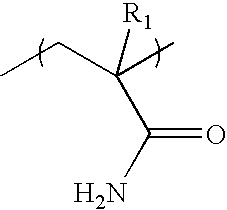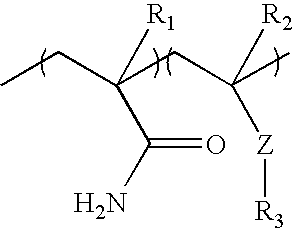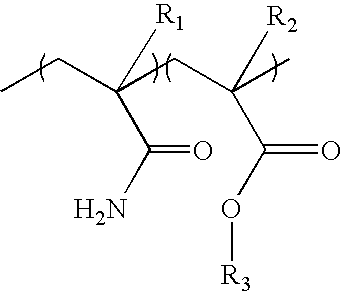Dispersible alcohol/cleaning wipes via topical or wet-end application of acrylamide or vinylamide/amine polymers
a technology of amine polymer and wipe, which is applied in the direction of weaving, synthetic resin layered products, chemistry apparatus and processes, etc., can solve the problems of inability to create an economical coherent fibrous web, inability to disperse binders in water containing more than about 15 ppm casup>2+/sup> and/or mgsup>2, and achieve the desired strength of the fibrous substrate. , the effect of enhancing th
- Summary
- Abstract
- Description
- Claims
- Application Information
AI Technical Summary
Benefits of technology
Problems solved by technology
Method used
Image
Examples
example 1
[0171]Wetting Composition Preparation
[0172]ACS reagent grade or better of isopropanol (IPA), acetone (ACE), t-butyl alcohol (TBA), n-butyl alcohol (NBA), n-propanol (NPA), ethanol (EtOH) or methanol (MeOH) were used in formulating the wetting solutions used in the following examples. The concentrations of these insolubilizing agents in the wetting compositions ranged between 60% and 100% (neat). Where the concentration of the insolubilizing agents in the wetting compositions was below 100%, insolubilizing agent was combined with deionized water.
[0173]Fibrous Substrate Sample Preparation
[0174]Two different fibrous substrates were used to evaluate the performance of the triggerable binder formulation: UCTAD tissue and thermally-bonded air-laid nonwoven.
[0175]UCTAD Tissue
[0176]An uncreped through-air dried (UCTAD) tissue fibrous substrate with a basis weight of about 50 gsm and a caliper of about 1.3 mm was used to evaluate samples of the triggerable binder formulations. Eucalyptus woo...
example 2
[0192]An anionic polyacrylamide polymer, commercially available under the trade designation of Baystrength® 85 from Bayer Corporation, was evaluated as a triggerable binder formulation on the UCTAD and TBAL fibrous substrate samples as described above. The Baystrength® 85 polymer was applied to the fibrous substrate samples as described above. The triggerable binder formulation add-on level for each fibrous substrate sample ranged from 1.8 wt. % to 10 wt. %. The treated fibrous substrate samples were allowed to equilibrate for in-use tensile strength measurements, as described above, in wetting compositions having an IPA content that ranged from 65% to 100%. Dry treated fibrous substrate samples were also tested for in-use tensile strength. The in-use tensile strength of the treated fibrous substrate samples, wet and dry, is presented in Table 3. The dispersibility or disposal strength of the treated fibrous substrate samples for 10 minute and 30 minute soaks in 200 ppm hard water a...
example 3
[0195]An UCTAD fibrous substrate sample having a basis weight of about 45 gsm and a caliper of about 1.3 mm commercially available from Kimberly-Clark Corporation, was used for evaluation of the Baystrength® 85 polymer as a triggerable binder formulation. This UCTAD fibrous substrate sample possesses a residual wet strength of about 40 g / in. in water. The results presented in Table 4 were not corrected for residual wet strength of the UCTAD fibrous substrate samples in this example. The Baystrength® 85 polymer was applied to the fibrous substrate samples as described above. The triggerable binder formulation add-on level for each fibrous substrate sample ranged from 2 wt. % to 5 wt. %. The in-use tensile strength and disposal strength for the treated fibrous substrate samples were evaluated as described in Example 1, with the exception that 100 ppm hard water (as metal ion) was utilized for soak tests. The treated fibrous substrate samples were allowed to equilibrate for in-use tens...
PUM
| Property | Measurement | Unit |
|---|---|---|
| weight percent | aaaaa | aaaaa |
| length | aaaaa | aaaaa |
| length | aaaaa | aaaaa |
Abstract
Description
Claims
Application Information
 Login to View More
Login to View More - R&D
- Intellectual Property
- Life Sciences
- Materials
- Tech Scout
- Unparalleled Data Quality
- Higher Quality Content
- 60% Fewer Hallucinations
Browse by: Latest US Patents, China's latest patents, Technical Efficacy Thesaurus, Application Domain, Technology Topic, Popular Technical Reports.
© 2025 PatSnap. All rights reserved.Legal|Privacy policy|Modern Slavery Act Transparency Statement|Sitemap|About US| Contact US: help@patsnap.com



